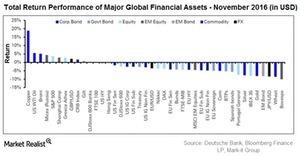Why Was November Important for Global Financial Markets?
Trump’s unexpected presidential victory caused short-term uncertainty about markets and policies. His win reinforced a reflationary theme in global markets.
Dec. 30 2016, Published 1:35 p.m. ET

VanEck
No matter one’s point of view, November was a watershed month for global financial markets. The immediate reaction for holders of emerging markets bonds was to sell first and ask questions later. This sell-then-ask process has been the fate of many risk markets over the past decade. For emerging markets bonds, it did not take long for prices to move significantly lower and then usher in the “ask questions” phase. The market reaction was swift, with higher rates and a stronger U.S. dollar. This continued after the Federal Reserve delivered an expected rate increase following their meeting on December 13-14, but with an unexpectedly hawkish forecast for 2017.
Market Realist
November – an important month for global markets
In November, Donald Trump’s unexpected presidential victory caused short-term uncertainty about markets and policies. Uncertainty occurred in the US and around the globe. Trump’s win reinforced a reflationary theme in global markets (ACWI). The above chart shows global financial assets’ total return performance in November. In a note to clients at the beginning of December, Jim Reid, a Deutsche Bank AG strategist, wrote, “The U.S. election result just over 3 weeks ago sparked a huge divergence across asset classes and also between developed and emerging markets.”
How did the rate hike impact emerging market debt?
A stronger dollar impacts the performance of emerging markets. The anticipation of Fed rate hikes in early 2016 pushed the US Dollar Index higher. The PowerShares DB US Dollar Bullish ETF (UUP) tracks the performance of the US Dollar Index. Since the Fed kept rates unchanged, the index started falling in mid-2016. Positive expectations of a rate hike in December pushed the index up. At the Jackson Hole Economic Symposium, Fed Chair Janet Yellen was optimistic about another rate hike in the US. Between the election and the December rate hike, the US Dollar Index rose 3.4%.
On December 14, 2016, the Fed announced its rate hike. Since then, it strengthened by another 2%. The US Dollar Index strengthens with interest rate hikes. The US Dollar Index and emerging market debt (PCY) are negatively correlated. Between December 21, 2013, to December 21, 2016, the US dollar (UUP) was negatively correlated with emerging market debt (EMB). As of December 20, the emerging market debt (EMLC) performance has fallen 1.2% since the Fed rate hike.
In the next part, we’ll discuss emerging market debt in 2016.
